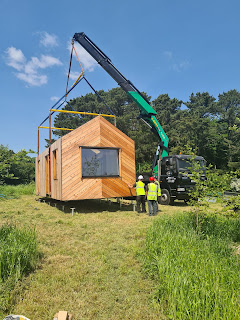The concept of using pre-assembled components in home construction is not new and many would argue that modern tech-enabled modular housing offers a faster and more sustainable solution to housing crises. However, while some countries have embraced this approach, others like the U.K. have struggled to scale it up.
Prefabrication has a long history, from William the Conqueror's defences in 1066 to Sears' mail-order homes in the early 1900s.
Today, entire modules can be constructed in factories and assembled into houses within weeks, offering advantages like speed and sustainability. This is particularly crucial in countries like the U.K., where affordable housing shortages persist.
Modular housing, built in controlled factory environments, generates less waste and results in more energy-efficient homes.
For example, British modular developer TopHat Communities reported sending "zero waste to landfill" in the last three years. Additionally, modular construction reduces vehicle movements to development sites, as highlighted by a 2022 report from Make UK Modular.
Studies have shown that modular home construction can significantly reduce embodied carbon emissions by up to 45%.
Despite these benefits, the sector has faced setbacks, with firms struggling to profit amidst challenges like high energy costs and interest rates.
The construction industry, including modular housing, experiences a high rate of failures. Factors like perceptions based on past versions of prefabrication and industry conservatism hinder widespread adoption of new methods.
Countries like Sweden and Japan lead in prefabrication, with significant portions of their housing stock built using offsite construction methods. In contrast, the U.K. and U.S. lag behind, with limited adoption of modular housing.
Efforts to address affordable housing shortages in the U.K. include ambitious targets set by the government and opposition parties.
The current U.K. government has the target of building 300,000 homes a year, but 234,400 were built in 2022-23. Keir Starmer, the leader of the Labour party, has pledged to build 1.5 million homes within a five-year term if his party is elected. That's 300,000 houses a year, and there is zero chance of that happening if there is not some form different approach adopted
Modular construction could play a role in meeting these targets, but widespread adoption may take time.
a Make UK Modular report published last year said more than 3,000 modular homes were being built in the U.K. annually, though there was capacity to build five times that number
In comparison to the already mentioned Sweden and Japan who are cited as leaders in the prefab build market. Savills Research highlighted in 2020 that 45% of homes in Sweden were built using offsite construction. In Japan, it said modular construction was used in building 15-20% of new homes, which equated to between 150,000 and 180,000 homes a year
Looking ahead, there is optimism for the modular sector, with potential for increased adoption in the coming years. However, other modern methods of construction, such as panellised solutions, may also gain traction alongside modular housing.

No comments:
Post a Comment